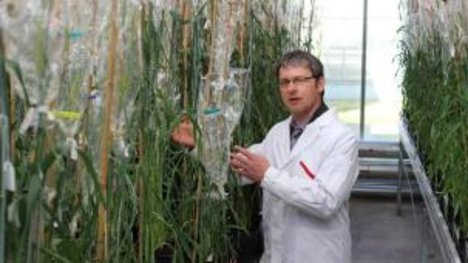Treasure hunt in the rye

Scientists from the Julius Kühn-Institut in Quedlinburg are protecting the future of rye bread. Behind this simple mission statement lies some highly complex plant research. The team under breeding research scientist Dr. Bernd Hackauf has set itself a difficult task: they are working on mapping the rye genome. “We want to understand which parts of the genome are responsible for specific qualities,” he explains. “Like detectives looking for the genetic fingerprint of the culprit at the scene of a crime, we are on the hunt for the genetic fingerprint of rye plants.”
The researchers’ goal is to find varieties of rye with specific characteristics. “The rye genotype has ‘hidden treasures’, for example genes resistant to diseases and stress-tolerance genes that ensure that the grain can also flourish on dry, sandy and poor soil,” explains Bernd Hackauf. To allow these treasures to be used for breeding, he and his research team have been working for a number of years on various projects to investigate the genetic make-up of rye. “It’s like a jigsaw puzzle: we break up the DNA of a rye plant into its constituent parts and then fit them back together.”
The scientists are working in networks ‑ for example with the Institute of Crop Plant Research in Gatersleben, the Technische Universität and the Helmholtz research centre in Munich. “Solving such a complex problem on our own is just not feasible,” says Hackauf. The breeding researchers reached a key milestone back in 2013: they established the position and sequence of over 22,000 rye genes, on which basis they were able to publish a model of the rye genotype.
Yet their work is by no means done. The focus now is on finding those aspects of the rye genome that contain the dispositions for desired quality characteristics. Using genetic markers, researchers can then test a new variety at the seed stage, in the laboratory, for those characteristics ‑ for example whether it can withstand disease or certain weather/atmospheric conditions and provide a reasonable yield even in difficult conditions.
The new molecular biology technologies in plant breeding which Bernd Hackauf and his team and partners use complement traditional methods. Originally, it was far more difficult after cross-breeding for breeders to find that plant amongst thousands that had passed on exactly the characteristics required. The process from cross-breeding to variety took over a decade, and was like trying to find a needle in a haystack. Nowadays, breeders can save time and money with modern breeding techniques which the scientists call SMART breeding or precision breeding.
“These methods speed up the process enormously,” says Bernd Hackauf. “For new cross-bred varieties, we no longer have to cultivate hundreds of plants and expose them to fungus, aphids or other stress factors just to see whether the new variety is hardier than the existing ones.” Instead, he explains, they can systematically look through the genotypes of thousands of plants to pinpoint the gene sequence that gives the plant a certain characteristic. This speeds up the breeding process, as subsequent field testing in real-life agricultural conditions can then concentrate on those plants that have the required feature.
This is how it works in practice: the researchers try to “map” the genotype to facilitate their search. They want to know which pieces of the plant DNA are responsible for which characteristic. Once they have solved that puzzle, they can then cross the plant with the relevant gene with high-yield varieties, and determine the exact characteristics of the new variety of rye. Scientists can therefore optimise characteristics such as resistance, plant size, flowering time, stability and grain size. Bernd Hackauf explains that “this is a necessary process as farmers and consumers have specific expectations of rye as a food and as a feed grain. Breeders want to meet those expectations, and our research helps them to do so.”
Grain breeding always seeks to achieve steady grain yield in a constantly changing environment. Global warming is favourable to fungal diseases, for example, which are rising sharply and becoming a serious problem. The same applies to aphids, which can carry viruses. ,On the basis of the gene sequences we now know, we can, for example, identify in the genome resistances to pests,” explains Bernd Hackauf, summing up the success of the rye “treasure hunt” to date.
Working between the Institute headquarters in Quedlinburg and test fields in Groß Lüsewitz in Mecklenburg, the researchers from Saxony-Anhalt are ensuring that traditional grain has a future. Their work is also of great importance to the economy: Germany is the third-largest rye producer in the world after Russia and Poland. Innovative breeding research means that Germany has high-yield, high-performance varieties ‑ farmers currently have a choice of 45. “We are providing the scientific basis for continuing, ongoing improvement to rye in future,” Bernd Hackauf promises. “We also want future generations to be able to enjoy a great rye or rye mix bread.”
Author: Dana Toschner
Caption: Dr. Bernd Hackauf in the greenhouse. Plants identified by their genetic fingerprint as the carriers of valuable genes are crossed with high-yield rye plants in the greenhouse.
